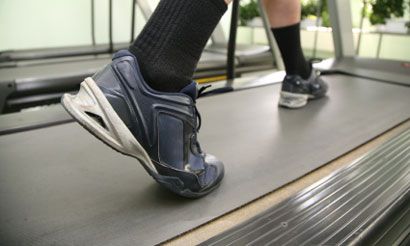Preclinical Trial Shows Exercise Increases Efficacy of Chemotherapy
Solid tumors often have an abnormal web of blood vessels, creating areas of hypoxia that protect the tumor from the toxic effects of chemotherapy drugs and radiation, which are designed to seek out well-oxygenated tissue.
Solid tumors often have an abnormal web of blood vessels, creating areas of hypoxia that protect the tumor from the toxic effects of chemotherapy drugs and radiation, which are designed to seek out well-oxygenated tissue.

A Q & A With Mark W. Dewhirst, DVM, PhD
Solid tumors often have an abnormal web of blood vessels, creating areas of hypoxia that protect the tumor from the toxic effects of chemotherapy drugs and radiation, which are designed to seek out well-oxygenated tissue. Because exercise has been shown to improve blood vessel growth and perfusion of normal tissues, investigators at Duke Cancer Institute (DCI) sought to determine whether or not it might have the same effect in solid tumors. Theirfindings were publishedMarch 16, 2015, in theJournal of the National Cancer Institute.
The investigators assessed the effect of exercise on breast cancer tumor growth and response to treatment in mice with orthotopically implanted estrogen receptor (ER)-negative and ER-positive tumor cells and randomly assigned the mice to exercise (running on a wheel) or sedentary control. The investigators found that the mice that exercised had significantly reduced tumor growth and a 1.4-fold increase in apoptosis. Microvessel density was also approximately 60% higher in exercised mice compared with the sedentary mice, and oxygen transport to the tumors was improved, with a tumor vasculature that appeared and behaved more normally.
Based on these findings, the researchers tested whether or not exercise would also improve the efficacy of chemotherapy. They randomly assigned the mice to one of four groups: sedentary, exercise alone, cyclophosphamide alone, or exercise plus cyclophosphamide. They found that the rate of tumor growth was significantly slower in mice treated with exercise plus cyclophosphamide compared with all other groups. Although tumor growth was also delayed in the exercise alone and cyclophosphamide alone groups, there was no difference in tumor growth rate between those two groups, suggesting exercise had similar effects as chemotherapy in their experiment.
“We were truly amazed by these findings,” said co-senior author Mark W. Dewhirst, DVM, PhD, the Gustavo S. Montana Professor of Radiation Oncology, and vice director for Basic Science at DCI, in a DCI press release. “I have spent the better part of the last 30 years trying to figure out how to eliminate hypoxia in tumors, and have looked at a lot of different approachesdrugs, hyperthermia, and metabolic manipulations. None has worked very well, and in some cases, made things worse. So these findings with exercise are quite encouraging.”
Targeted Oncologyhad the opportunity to discuss the study and its findings in greater detail with Dewhirst.
What is the most important finding of your study?
Dewhirst:That exercise simultaneously increases blood flow and oxygen delivery to tumors. The increase in blood flow will increase drug delivery to cancers, thereby increasing the likelihood that cancer cells will be exposed to enough drug to kill them. The increase in oxygen also increases sensitivity of tumor cells to chemotherapy and radiation therapy.
What do you think is the mechanism behind exercise reducing oxygen starvation of tumors?
Exercise seems to stimulate tumor blood vessel growth, in addition to opening existing blood vessels. We do not know the mechanism for certain. This is a subject of ongoing research.
Your study used mouse models that performed exercise by running on a wheel. Do you think the effects you observed would only be seen with high-impact aerobic exercises, or do you think other exercises (eg, yoga, weight-bearing exercises) might also show benefit?
The benefit comes from performing aerobic exercise. We do not have any evidence that weight-bearing exercise has the same benefit, and I cannot make any predictions about yoga. If there were an effect with yoga, it would be through a different mechanism than what is achieved with aerobic exercise.
You also examined how exercise worked in combination with a chemotherapeutic agent. Do you think exercise has the potential to increase the efficacy of other treatments as well, including some of the more targeted therapies?
I do believe that it will improve the efficacy of many drugs, including targeted therapies. One of the major limits to achieving better efficacy of any drug is achieving sufficient concentrations of drug in the tumor. Tumor blood vessel function is very abnormal and this abnormality limits efficiency in drug delivery. We happened to look at cyclophosphamide, but the improvement in perfusion would be expected to increase the delivery of any drug to tumors.
What should healthcare providers keep in mind as they learn about your study?
We know from this study and others that exercise can reduce tumor growth rate. What we do not know yet is how much exercise is sufficient to see a benefit. That is the subject of ongoing research.
Patients with cancer reading about your findings may be inclined to start exercising. What would you tell such patients?
It would be best for them to focus on aerobic training. It is difficult at this time to give them a precise prescription of exercise; however, theguidelines set by the American Cancer Societywould be a good place for them to start.
What other studies do you have planned?